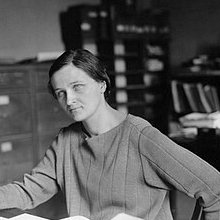
Cecilia Payne-Gaposchkin was a British-born American astronomer and astrophysicist who proposed in her 1925 doctoral thesis that stars were composed primarily of hydrogen and helium. In 1919 while at Newham college at Cambridge, she became interested in astronomy after hearing a lecture by Professor Arthur Eddington about an eclipse expedition. She did not receive a degree, as Cambridge did not grant degrees to women until 1948. In 1925 she became the first person to earn a PhD in astronomy from Radcliffe College of Harvard University. Her groundbreaking thesis was initially rejected because it contradicted the scientific wisdom of the time, which held that there were no significant elemental differences between the Sun and Earth. Independent observations eventually proved she was correct. Henry Norris Russell, who reached the same conclusions by different means, was generally credited for her discovery although he cited her work briefly in his paper.
She spent her career at Harvard, where because she was a woman, she initially worked in low-paid research jobs. In 1938 she was eventually given a proper faculty job, and in 1956 became the first woman to be promoted to full professor from within the faculty at Harvard's Faculty of Arts and Sciences. Her work on the nature of variable stars was foundational to modern astrophysics. Read more.
